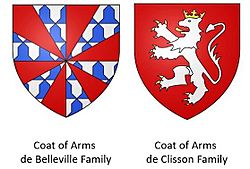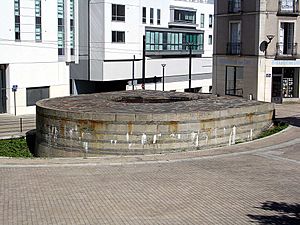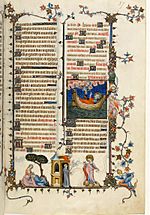Jeanne de Clisson facts for kids
Quick facts for kids
Jeanne Louise de Belleville, de Clisson
|
|
|---|---|

Dual Coat of Arms of the de Belleville and de Clisson Families with the motto:"Pour ce que il me plest" (For what pleases me)
|
|
| Born | 1300 Belleville-sur-Vie, France
|
| Died | 1359 Hennebont, Brittany
|
| Nationality | Born French, married Breton |
| Other names | Jeanne de Belleville |
| Spouse(s) |
|
| Children | Geoffrey IX de Châteaubriant, Louise de Châteaubriant, Isabeau de Clisson, Maurice de Clisson, Olivier V de Clisson, Guillaume de Clisson and Jeanne de Clisson, Stepson: Jean de Clisson |
| Piratical career | |
| Nickname | Lioness of Brittany |
| Type | Privateer |
| Allegiance | First allegiance: Party of Blois: |
| Years active | c. 1343 – c. 1356 |
| Commands | Black Fleet; My Revenge |
Jeanne de Clisson, Lady Bentley (1300–1359), also known as Jeanne de Belleville and the Lioness of Brittany, was a brave French and Breton noblewoman. She became a privateer (a legal pirate working for a government) to get revenge. Her husband was executed by the French King Philip VI, and Jeanne believed he was innocent.
She sailed her ships across the English Channel, attacking French ships. She would often defeat their crews, but always left at least one sailor alive. This survivor would carry her message of vengeance back to the French King.
Contents
Jeanne's Early Life and Family
Jeanne Louise de Belleville, de Clisson, was born in 1300 in Belleville-sur-Vie, France. Her father was Maurice IV Montaigu of Belleville, a nobleman. Her mother was Létice de Parthenay.
Her family were important lords in the Poitou area. They were involved in businesses like winemaking and salt farming. They also traded these goods by ship, reaching places like Spain and England. This meant they knew a lot about merchant shipping along the Vie river and the coast.
Jeanne's father died when she was four years old. In 1320, she inherited her family's lands when her half-brother, Maurice V, passed away without children.
First Marriage and Children
In 1312, Jeanne married her first husband, Geoffrey de Châteaubriant VIII. He was a Breton nobleman. They had two children:
- Geoffrey IX (1314–1347), who inherited his father's lands.
- Louise (1316–1383), who later inherited her brother's estate.
Second Marriage and Annulment
In 1328, Jeanne married Guy de Penthièvre, who was the second son of the Duke of Brittany. This marriage was likely to protect her young children.
However, this marriage did not last long. Relatives of the Duke complained to the church, and the marriage was cancelled by Pope John XXII in 1330. Guy then married someone else but died unexpectedly in 1331.
Marriage to Olivier IV de Clisson
In 1330, Jeanne married Olivier IV de Clisson. He was a rich Breton lord who owned a castle at Clisson and lands in other areas. Olivier had a son, Jean, from his first marriage.
Jeanne also owned lands in Poitou, south of Brittany. By combining their properties, Jeanne and Olivier became very powerful lords in the border region of Brittany. Jeanne made sure her children from her first marriage would keep their inheritance.
Jeanne and Olivier had five children together:
- Isabeau (1325–1343)
- Maurice (1333–1334)
- Olivier V (1336–1407), who became a famous military leader.
- Guillaume (1338–1345)
- Jeanne (1340–?)
At one point, Jeanne even took Olivier to court to make sure she received money from his estates as agreed in their marriage contract. King Philip VI heard the case and ruled in her favor.
The Breton War of Succession
During the Breton War of Succession, Jeanne and Olivier supported Charles de Blois. He was the French choice for the new Duke of Brittany. The English supported John de Montfort.
In 1342, the English captured the city of Vannes. Jeanne's husband, Olivier, was one of the military leaders defending the city. He was captured but was released after a prisoner exchange for a surprisingly low amount of money. This made Charles de Blois suspect that Olivier had not fought hard enough and might be a traitor.
Olivier's Arrest and Execution
In January 1343, a peace agreement called the Truce of Malestroit was signed. Under this truce, Olivier and other lords were invited to a tournament in France. However, Olivier was arrested there, taken to Paris, and put on trial.
Jeanne tried to help Olivier get free, even attempting to bribe a royal officer. Because of this, Jeanne was accused of rebellion against the King. She managed to avoid arrest, protected by Olivier's eldest son, Jean de Clisson. Jeanne ignored the summons and was found guilty in her absence in June 1343.
On August 2, 1343, Olivier IV was executed by beheading in Paris. This execution shocked many nobles because the evidence against him was not made public. Also, beheading was usually for lower-class criminals, not nobles.
On August 26, 1343, Jeanne was also charged with a serious crime against the King. She was banished and her property was taken away.
Jeanne's Vow of Revenge
Jeanne took her two young sons, Olivier and Guillaume, to Nantes. There, she showed them their father's head displayed on a pole at the Sauvetout gate.
Jeanne was furious and swore to get revenge on King Philip VI and Charles de Blois. She saw her husband's execution as a cowardly murder.
Jeanne Becomes a Privateer
After Olivier's execution, Jeanne sold her lands. She gathered about 400 loyal men and began attacking French forces in Brittany.
She is said to have attacked:
- A castle at Touffou, where her forces defeated the garrison.
- A garrison at Château-Thébaud, which used to be controlled by her husband.
The Black Fleet
With help from the English king and Breton supporters, Jeanne prepared three warships. These ships were painted black, and their sails were dyed red. Her main ship was named My Revenge.
These ships were likely cog-type vessels, which were cargo ships that could be adapted for fighting. They would have added structures for combat.
Jeanne's Black Fleet first attacked ships in the Bay of Biscay, from the island fortress of Yeu. Later, they moved into the English Channel, hunting French merchant ships. Her crews would defeat the enemy, but always left a few witnesses to tell the French King what had happened. This is how Jeanne earned her nickname, "The Lioness of Brittany."
This type of fighting is called commerce raiding. It's like guerrilla warfare at sea, aiming to disrupt the enemy's supplies and trade rather than fighting big battles. Jeanne's ships would work together, using grappling hooks to board enemy vessels. Their crews used weapons like crossbows, swords, and daggers.
Areas like the Gironde estuary and the islands of Oléron were especially dangerous. The Pointe du Raz was a good spot for ambushes because of its many small islands. Local stories say Jeanne used her family's castle on Yeu for her first attacks. She also attacked coastal villages in Normandy.
Jeanne is sometimes called an English privateer, meaning she might have had official permission from the English king. In 1346, during the Crécy campaign, Jeanne used her ships to supply the English forces.
Eventually, the French managed to fight her fleet and sink her main ship. Jeanne and her two sons were stranded at sea for five days. Sadly, her son Guillaume died from the cold. Jeanne and Olivier were rescued by supporters of Montfort and taken to Morlaix. Jeanne continued her privateering in the Channel for another 13 years. Both the French and English kings used privateers to attack each other's shipping.
Fourth Marriage
In the 1350s, Jeanne married for a fourth time to Walter Bentley. He was an English military leader under King Edward III. Bentley was rewarded with lands and castles for his services.
Later Life and Death
Jeanne and Walter faced some disputes over her properties. Walter was even imprisoned for a time for refusing to give up some of Jeanne's castles to the French. However, he was later released.
By 1357, Walter and Jeanne were given the barony of La Roche-Moisan as compensation.
Jeanne eventually settled at the Castle of Hennebont, a port town in Brittany. Walter died in December 1359, and Jeanne passed away a few weeks later.
Local Stories and History
The Sea Castle of Ile d'Yeu
The lords of Belleville owned the island of Yeu, which was important for their sea trade. Jeanne inherited Yeu and had the old wooden fort replaced with a stone fortress. This was to help protect against pirate raids. When she married Olivier, he added to the castle's design. This castle was later taken by the French King. Local stories on Yeu talk about "red men" (English soldiers) who came to rescue Jeanne when she was trapped by the French.
Historical Evidence of Jeanne's Life
Many records confirm details about Jeanne's life and actions:
- Church records show the annulment of her second marriage.
- A French court ruling from 1343 found Jeanne guilty and confirmed her lands were taken.
- English court records from 1343 show King Edward granting Jeanne an income from lands controlled by the English.
- Jeanne is mentioned as an English ally in the truce between France and England in 1347.
- A 15th-century manuscript, the Chronographia Regum Francorum, confirms parts of her story.
- Records show that after Olivier's execution, several other knights were also accused of similar crimes and executed.
- The Belleville Breviary, a beautiful prayer book from 1323–1326, is linked to Jeanne. It is believed she received it as a wedding gift when she married Olivier.
- The Treaty of Westminster of 1353, though lost, is known to have included a clause about property rights in Brittany, especially for English people married to Breton heiresses.
- Many other historical chronicles and records from the 14th century mention events related to Jeanne's life and the wars of that time.
Jeanne's Legacy
Jeanne's lands were part of lawsuits after her death. Her daughter Louise tried to stop the King from giving away the family's lands after they were taken.
In 1868, a French-Breton writer named Émile Pehant wrote a novel called Jeanne de Belleville. This book helped share many details of Jeanne's story and the legends about her.
On September 24, 1999, the City Council of Nantes named a street in her honor: "Rue Jeanne la Corsaire, wife of Olivier de Clisson, 1300–1359."
See also
- Belleville Breviary, a famous book of prayers.
- Cog (ship), a common type of ship used for trade and sometimes war during that time.
- John Crabbe (died 1352), another pirate who worked for different kings.
- John Hawley (died 1408), a contemporary pirate also in the employ of the English.





